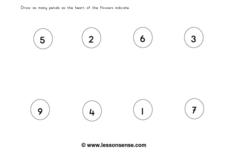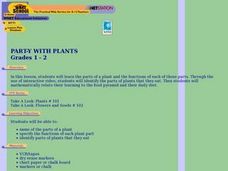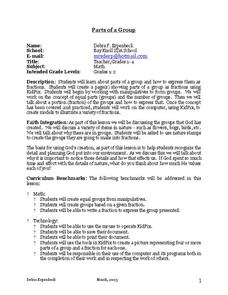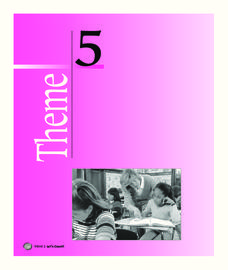Curriculum Corner
Bugs and Flowers Math and Literacy Centers
The sun shines, flowers bloom, and bugs fly—it must be Spring! Add a cheerful theme of bugs and flowers to math and literacy centers. Scholars take part in an assortment of activities designed to reinforce concepts such as...
Curated OER
6: Parts of a Flower
Students draw and label the parts of a flower using a coin from the Northern Mariana Islands. For this flower parts lesson, students look at a transparency of the reverse side of a quarter from the Mariana lslands. They discuss the...
Curated OER
Flower Petals
In this artistic related worksheet, students draw as many petals as each heart request in the circles on the flowers indicated.
Curated OER
Draw a Picture - Fractions
Learners solve six word problems where they draw pictures in order to identify fractions as parts of a group or to compare fractions. Great practice for your third and fourth graders.
Curated OER
Some Early Spring Flowers
In this counting flowers worksheet, students cut out five different bouquets of flowers, count how many flowers are in each bouquet and then place each bouquet in the appropriate numbered vase.
Curated OER
Colorful Nutrients
Students participate in an experiment to understand how plants get nutrients. In this plant nutrition, lesson students examine how colored water goes through the stem of a plant to the flower. Students discuss the parts of the flower and...
Yummy Math
Valentine’s Day = Roses
Roses are red, but did you know that some are lighter while others are darker? Scholars read an infographic to decipher the fraction and percent of rose color and their country of origin. They go on to make comparisons and estimate while...
Curated OER
Part of a Whole Group
In these two recognizing fractions worksheets, students review examples, observe boxes with two different kinds of things, and use them to write each part as fractions. Next, they circle items to make groups to use to complete number...
Curated OER
Flower Vases
Which vase holds more water: a cylinder, sphere, or cone? Figure out which should be used for your sister's birthday bouquet with this practical word problem.
Curated OER
Section 2.5 - Problem Solving (Part B)
Trying to figure out the perimeter of a geometric figure? Here are a few word problems to set up algebraic equations to solve for perimeter. There are also some word problems to set up algebraic equations to solve for angles in a...
Curated OER
Body Language
First graders investigate the three main parts of a plant. In this plant parts instructional activity, 1st graders explore vocabulary for the topic and read a story about plant parts. Students view a PowerPoint and take a quiz for...
Curated OER
Party with Plants
Students watch a video on plant parts and identify the function of plant parts. In this plants lesson plan, students identify the parts of plants they eat and relate it back to the food pyramid and perform math problems as they do this.
Curated OER
Parts of a Group
Learners use manipulatives to form groups and then create a page showing parts of a group as fractions using KidPix. They work on the concept of equal parts and the number of groups discussing fractions of the groups and how they would...
Curated OER
Tiptoe Through the Tulips
For this estimation worksheet, 3rd graders look over 4 pictures and choose by multiple choice what part of each garden is planted with tulips. Students draw two original maps as requested at the bottom of the worksheet.
Houghton Mifflin Harcourt
Let’s Count!: English Language Development Lessons (Theme 5)
Counting is the theme of this compilation of ESL lessons. Through listening, speaking, and moving, your young learners take part in a variety of activities to enhance their English proficiency such as making menus and books,...
EngageNY
Mid-Module Assessment Task: Grade 6 Math Module 4
Halfway through the module — the perfect time for an assessment. The 18th installment of a 36-part series is a mid-module assessment. Scholars provide evidence of understanding through various mathematical and contextual problems.
Curated OER
To Be (Half) Or Not To Be (Half)
First graders demonstrate various ways to represent and verify a whole or set separated in two, three, or four equal parts. Using interlocking cubes, Students model a part of a whole or a part of a set. They use appropriate tools and...
Curated OER
Pumpkins . . . Not Just Part of Halloween
Students study the pumpkin. In this pumpkin lesson, students participate in different activities that explain the history of pumpkins and how pumpkins develop and grow, read "The Great Pumpkin Story" and answer comprehensive questions...
Math Mammoth
Understanding Percent
For this understanding percent worksheet, students fill in the missing parts for examples of number of colored parts and total numbers and use them to complete charts and rewrite sentences using the exact amount of things and percents....
Curated OER
Leaves, Flowers, Seashells, Mirrors and Symmetry
Students develop an understanding of patterns and symmetry. In this symmetry and pattern lesson, students use real world patterns then analyze and extend them. Students also use real world items while discovering and observing...
Curated OER
April Showers Bring May Flowers
In this counting to 30 worksheet, students connect the dots from one to thirty in a dot to dot puzzle. A rainy day picture with an umbrella will be revealed.
Houghton Mifflin Harcourt
Unit 3 Math Vocabulary Cards (Grade 1)
Reinforce math vocabulary with a set of flashcards. Each card showcases a boldly typed word or a picture representation with labels. The topics are geometry related and include terms such as cones, faces, pyramids, sides, and...
DK Publishing
Dot-to-Dot
What is hidden among these numbers? Beginning counters connect the dots to complete an image of two flowers using the numbers 1-12. The fun part here is that they get to draw their own connect-the-dots image below; something youngsters...
Curated OER
Design Engineer Problem
Students design a flower-pot and saucer. For this math lesson, students incorporate the use of technology to correctly build and shape a flower pot. They calculate the necessary mass of the red clay used to make the pot.























